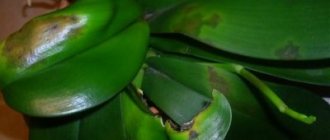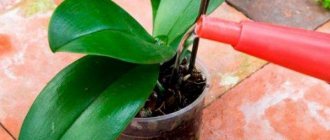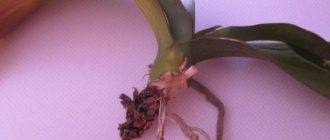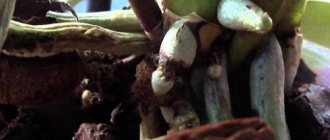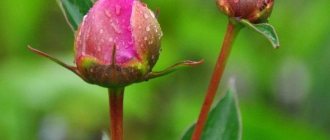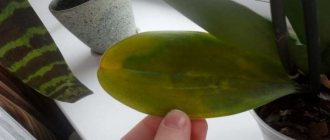Care errors
When the color of orchid leaves changes, first of all, check compliance with the rules of care. Thus, under the influence of direct sunlight, burns appear, which are characterized by reddening of the leaves. This happens because the leaf produces a protective red pigment to protect against burns.
For reference! If sunburn occurs, yellow spots may appear on the leaves.
The orchid is shaded from direct sunlight by blinds and a sheet of paper. The sun is especially dangerous in the spring, when the orchid is no longer artificially illuminated, but is exposed to the sun. During such a transition period, the window should be shaded, for example, with tulle. The orchid is fed to strengthen the immune system. Lack of phosphorus is also one of the possible reasons for leaves turning red.
For reference! The orchid is moved to another place if the change in color is followed by tissue death. This signals a burn. However, if the leaves do not curl, do not lose turgor, and the plant blooms, then this is a natural color.
Before the actual burn appears, the leaves range in color from dark red to inky black. It is most often found on Cattleyas, which are prone to red pigmentation of the leaves. There are varieties that do not bloom without first darkening the leaves. In this case, a change in color indicates sufficient lighting.
When there is insufficient light, the leaves stretch out and turn light green. The orchid is weakening. This state of the plant is ideal for the appearance of pests and diseases.
Harm from ultraviolet radiation
Usually the most common cause is ultraviolet radiation, which burns the leaves of the flower. An orchid is a special “sissy” that must literally be cared for and cherished. A flower cannot exist without the sun, but it dies from its scorching rays.
Leaving the plant for at least a couple of hours in the direct rays of the heavenly body, and you won’t be surprised why the leaves of the orchids turned red. In some cases, the plates may still dry out and begin to curl. The situation can be eliminated, but only partially. The affected leaves will need to be cut off and the flower moved to a darker place or simply shaded. It would also be a good idea to fertilize the flower, which will help it recover faster.
Diseases
One of the symptoms of fungal diseases may be the leaves becoming reddish-brown. The difference from an ultraviolet burn is the presence of small specks, which over time combine to form large spots.
Anthracnose is a disease caused by a fungus. It appears with high air humidity and accumulation of liquid in the axils of the leaves. Inspect the lower part of the leaf and shoots for spots. They will have a dry core, often cracked with holes, and a clearly visible border around the edges. The color of the border will be dark pink and lilac. The disease sometimes affects pseudobulbs. Over time, the spots increase in size, become depressed, and a yellowish or pinkish coating appears.
Brown rot is characterized by dark brown spots, but depending on the original color of the leaves, the spots may have a red tint. The affected areas soften and die. If the lesions are minor, the orchid can be helped. Otherwise, you just have to throw away the plant.
Problems, treatments and photos
Each problem has its own countermeasures. The main thing is to correctly determine the cause of the disease so that timely assistance can be provided and not harm the plant even more. Therefore, it is worth carefully checking the conditions of detention in order to make the correct diagnosis.
Below we will describe methods for treating common ailments of plant leaves, and photos will also be attached.
If a solid white coating and bubbles have formed
The appearance of bubbles and a white, loose coating can speak volumes . If, apart from stickiness and droplets of moisture, no other oddities are found, then it is worth reviewing the conditions of detention. The orchid reacts in this way to cold, or to excess moisture or feeding.
If pests are found, then action should be taken immediately. The cause of sticky leaves with plaque can be scale insects. These pests attack the lower part of the leaf. Necessary actions:
- Wipe the affected leaves with a swab to remove parasites.
- Wash the plant with soapy water.
- After complete cleansing, the air humidity should be increased.
The lesion can also be caused by spider mites. In this case, you must proceed as follows:
- Parasites are removed from the surface of the leaves.
- The window sill is thoroughly wiped and the flowerpot is washed.
- The plant is treated with pesticides (Fitoverm).
- Humidity increases throughout the recovery period.
IMPORTANT! An orchid affected by pests must be isolated from other plants, otherwise there is a risk of infection of healthy flowers.
They began to turn yellow and wither
This happens if the orchid does not have enough moisture. It is recommended to increase watering and air humidification. also check whether the orchid is exposed to drafts , because this can cause the leaves and roots to freeze, which can result in the flower dying.
It is much worse if the orchid is affected by rot. In this case, the trunk will darken and the leaves will wither and turn yellow due to excessive watering. In this case, you need to do the following:
- Remove the flower from the substrate and inspect the roots.
- Remove those that have dark spots or that do not absorb moisture when immersed in water (remain the same painful in appearance).
- Diseased leaves are removed.
- Afterwards, all sections are treated with activated carbon.
- The plant is placed in a greenhouse.
ADVICE! If the stem rots, then such an orchid cannot be saved. The plant should be discarded.
Next, you can watch a video that tells you what to do with yellow leaves:
Spots have formed
The appearance of black spots may indicate that the plant has received a serious burn. The orchid should be shaded or moved to a more shady place.
The second cause of such spots is viruses. First affecting the lower leaves, it gradually spreads to the entire plant. In most cases, such a flower will have to be thrown away - orchids can rarely overcome viral diseases. Moreover, a diseased plant can easily infect other orchids .
Another reason can be all kinds of fungi. The plant can be saved if treated in a timely manner, namely:
- All affected parts of the plant must be removed.
- Treat the cut areas with iodine.
- The orchid itself is treated with bactericidal preparations (Fitolavin).
- Subsequently, it is necessary to provide the flower with good air circulation.
ATTENTION! Black spots can also appear due to hard water. In this case, it is necessary to wipe the leaves with a weak solution of orange or lemon juice.
Pests
to a lack of nutrients by turning red leaves. However, the reason may be hidden in the presence of pests, which, by damaging the roots, trunk and leaves, prevent nutrients from reaching the plant cells from the substrate.
The presence of spider mites is manifested by a silvery coating on the back of the leaf blade. The color gradually changes to red-brown. Spider mites enter the room and settle on orchids from an open window, and are introduced into potted indoor roses. The pest loves dry, warm air.
An atypical but possible symptom of scale insects is small red dotted spots that change color to brown or black.
Why are leaves so important?
The leaves of the phalaenopsis orchid play a large role in its life . They, together with the roots, participate in photosynthesis, absorbing light. The flower also breathes through them - at the bottom of each leaf there are microscopic pores that absorb oxygen and moisture.
Along with all their functions, in most cases they are also a kind of alarm that notifies that the orchid is sick. You should listen to such signals, because diseased leaves cannot fully supply the plant with all the necessary substances, and the entire flower suffers from this.
What to do if the leaves turn red
There are varieties of orchids with red shades of leaves: Ludisia, Phalaenopsis Schiller. In this case, the red color is natural and nothing needs to be done.
To avoid burns, the lighting should be diffused; if possible, the pot should be placed on a west-facing window. Some types of orchids are placed in direct sun in the morning and evening hours, when the sun's rays are not aggressive.
If the redness of the leaves is caused by pests or diseases, chemicals are used. The treatment is carried out on the balcony or on the street, using personal protective equipment: a mask and gloves. After the procedure, wash your face and hands thoroughly.
Treatment of diseases
If there are suspicions of diseases and/or pests, the orchid is isolated from other indoor flowers. The plant is carefully removed from the pot, the roots are immersed in lukewarm water. Using tweezers or your hands, remove pieces of bark and other components of the substrate from the roots. Next, the rotten parts of the orchid are cut off with sterile instruments, the sections are sprinkled with cinnamon, activated charcoal or charcoal.
Note! Do not use alcohol-containing preparations to treat cuts: you will burn the roots.
Next, drugs are used. Use against rot and anthracnose
- " Quadris ". The product, penetrating the plant, fights infection. It begins to act an hour after spraying the orchid. The drug in an amount of 1 ml is diluted in 2 liters of water.
Advice! If the plant was not isolated in time and there is a fear of infecting other pets, all flowers are treated.
- " Acrobat " is a preventive and therapeutic remedy for fungal diseases. 4 grams of the drug are diluted in 1 liter of water. Apply no more than 3 times with an interval of 10-14 days.
- " Pure color " is a concentrated emulsion. Take 1 ml of the drug for 2-2.5 liters of water. The orchid is sprayed.
- " Aktellik " fights pests, including ticks. The leaves are sprayed with a solution of 1 ml of the product in 1 liter of water.
- "Apollo" . An effective means of combating mites and laid eggs. Practically non-toxic. Treatment is carried out with a solution of 1 ml of product per 1 liter of water.
- " Aktara " helps in the fight against scale insects. Highly toxic. 1 ml of the drug is diluted in 1 liter of water.
- “ BI-58 ” is a combined drug for scale insects. Take 1 ml of product per 1 liter of water.
Important! When treating anthracnose, treatment with a systemic fungicide is mandatory. This guarantees the neutralization of fungi deep in the tissues.
After all the procedures, the plant is transplanted into a new pot and the soil is changed. The container for the orchid is transparent, with smooth walls. Be sure to have drainage holes. In almost all varieties of orchids, the roots participate in photosynthesis, so access to light is necessary. The volume of the pot is selected according to the size of the root system. The plant is not allowed much freedom; the flower loves cramped spaces. A special soil is used for orchids. Collect them yourself or purchase them in a store. After recovery, watering is reduced and the orchid is not fed.
Getting rid of pests
Acaricides or insectoacaricides are used against spider mites. The orchid is transferred to the street or balcony and sprayed with a solution. Gloves and a mask are used, people and pets are removed from the premises. Place a plastic bag over the plant and leave it for several days. During the day, the homemade greenhouse is ventilated for 10-15 minutes. Treatment is carried out at intervals of 3-5 days, at least 3 times.
Note! Spider mites are dangerous because they feed on plant sap and cause bacterial, fungal and viral infections.
Scale insects and false scale insects parasitize on the branches or trunks of plants and live on the back side of the leaf. It feeds on orchid sap, secreting a sticky substance on which a sooty fungus is formed. The fungus spreads throughout the plant, clogging the pores, thereby preventing the orchid from breathing. The plant withers and its condition worsens.
A sign of the appearance of scale insects are sticky spots on the leaves. Females lay well-protected eggs. Young individuals spread throughout the orchid, feed on plant juices and look for a place of attachment. As a result, the orchid turns yellow and the leaves fall off.
If a plant is damaged, before treating it with chemicals, it is cleaned of scale insects and false scale insects. Use tweezers, a cotton swab, and a toothpick. Examine the axils of the leaves, their reverse side, stem and buds. Carefully, using tools, remove individuals.
Note! Be sure to sterilize instruments before use. Thus, in case of accidental damage to the plant, infection will not occur.
When all individuals have been removed, the soil is watered with a systemic insecticide of contact-intestinal action. The orchid sap becomes poisonous, and the scale insect that feeds on it dies.
Advice! The pot and window sill where the orchid stands are also treated.
The treatment is repeated twice with an interval of 15 days. When all the individuals have died, you can clean the plant from the “cocoons” with a toothbrush.
How to restore turgor?
The elasticity of phalaenopsis leaves is restored after determining the cause. Both fungicides and other systemic drugs will help restore turgor . In case of excessive or insufficient watering, a soil moisture scheme is developed. By properly applying fertilizers, the problem with fertilizing is restored. When overfeeding the plant, the roots are washed with warm water, and the flower is transplanted into new soil.
Normalizing care will help restore turgor to the leaves and create conditions for new growth.
Prevention
The first rule that will prevent problems with orchids and other indoor plants: a newly purchased flower is quarantined . For a period of 1 month, the pot with the plant is isolated from other flowers. For the first 2 days, the orchid is placed in a cool, dark place. This prevents excessive stress. Upon completion of quarantine, the plant is transplanted into fresh substrate. The pot is left the same (if it meets the above characteristics), but sterilized before filling with new soil.
Note! When transporting an orchid in cold and/or windy weather, the plant must be carefully packed in cellophane or paper, which is not removed for 1-2 hours after delivery to its destination. This is done to reduce stress and the risk of hypothermia.
Preventive measures consist of creating favorable conditions for the growth and development of the orchid in accordance with its variety. The location chosen is western. If it is not possible to place a flower on the west window, then:
- On the north side, the orchid needs artificial lighting. Daylight hours for all varieties must be at least 10 hours.
- On the south window, the flower must be shaded.
To strengthen the immune system, plants are treated with purchased drugs and homemade products. Among homemade solutions, garlic water and succinic acid have good reviews. To prepare the solution, take 1 clove of garlic, chop it, add 1 liter of cold water and leave for 24 hours in a warm place. To enhance the effect, add 1 tablet of succinic acid to the solution, which is pre-dissolved in hot water. Mineral fertilizers are also applied.
Note! A healthy plant does not need fertilizing. Fertilize a weakened orchid that has suffered from illness. The plant is fed during the period of active vegetative growth, in the first week after flowering. Before feeding, water the flower so as not to burn the roots.
To prevent brown rot and anthracosis, biological fungicides are used: Mikosan, Fitosporin, Alirin and Gamair, Trichodermin. In addition, it is recommended to treat the flower with copper sulfate once a month. Avoid mechanical damage to roots, leaves, buds, into which infection and fungus can penetrate. If the substrate was collected in nature, it is calcined before use. Often bark and moss brought from the street contain fungi and insects.
To avoid rot and anthracnose, water the orchid only when the soil is completely dry. To check the condition of the substrate, use a wooden stick. It is placed at a depth of 2-3 cm. Then they take it out and see whether it is dry or wet. Water when the stick is dry.
Important! Self-collected soil components are sterilized at elevated temperatures, since anthracnose can withstand negative temperatures.
When watering orchids, avoid getting water on flowers and buds. The axils of the leaves are blotted with a dry cloth, the pot is left in the bathroom to drain off excess liquid.
To prevent the appearance of spider mites, the air must be periodically humidified. Humidifiers are used, and a container of water or wet expanded clay is placed next to the orchid. The plant is watered with a warm shower and sprayed regularly. Orchids love fresh air, but mites do not. Therefore, it is important to carry out regular ventilation, while protecting the orchid from drafts.
Important! If the substrate elements were collected in nature, they are sterilized at high temperatures. An oven is used for this purpose. The bark can be boiled, left until completely dry, and soaked for 2 days before use.
To prevent the appearance of pests and diseases, the plant is periodically inspected. Pay attention to the roots (it’s good if the pot is transparent and the root system is visible). Examine the leaf axils and their reverse side. If there are even minor deviations, action should be taken. Often the plant cannot be saved because the disease has developed too much.
What diseases do phalaenopsis orchid leaves have? Step-by-step treatment instructions
sluggish;- yellow at the edges and in the middle;
- have plaque on the outer and inner parts;
- become dark or light;
- wrinkled, as if they had wrinkled skin.
Once a year, the orchid sheds its foliage, but not all of it, but only 2-3. At the same time, the plant itself is absolutely healthy and can bloom. This is a normal phenomenon, since the already outdated parts of the orchid dry out, and after a while new ones appear in their place.
